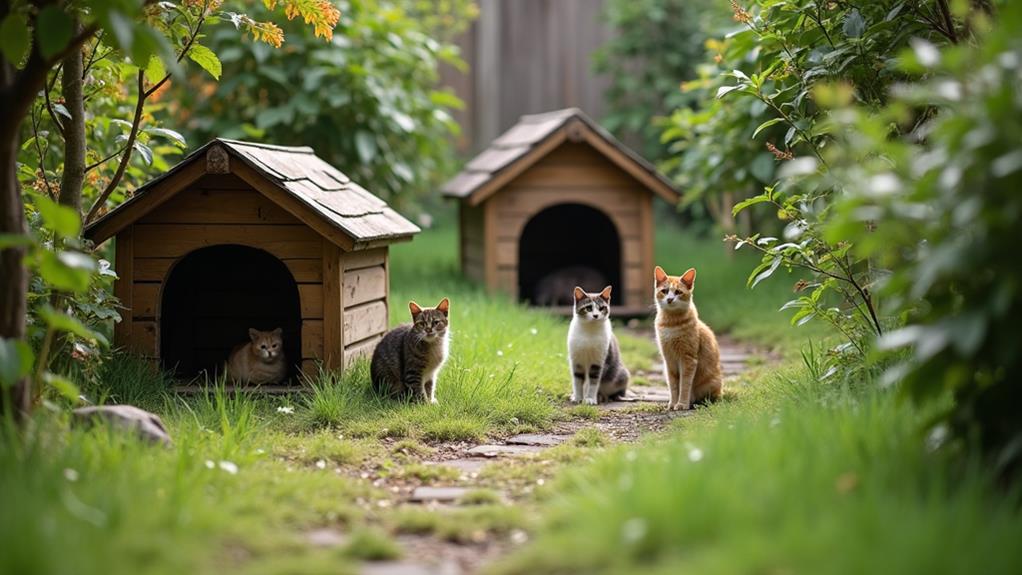How to Get Rid of a Feral Cat Colony: Humane Control Methods

To manage a feral cat colony humanely, start with the Trap-Neuter-Return (TNR) method. You'll trap the cats, get them spayed or neutered, vaccinate them, and then release them back. TNR helps control population and reduces territorial behaviors. Use repellents like pepper-based solutions or sharp mulch to deter cats from certain areas. Create community outreach programs to educate and gain support for TNR efforts. Remember, legal and ethical guidelines should guide your actions. Engaging your community and local animal control can lead to a more sustainable and humane approach, which might be exactly what you need.
Understanding Feral Cat Behavior
When dealing with feral cat colonies, understanding their behavior is crucial to managing them effectively. Feral cats are typically unowned and unsocialized, making them wary of human contact. They're nocturnal creatures, and their solitary nature makes them difficult to approach. These cats often establish colonies around consistent food sources, such as a feeding station, leading to higher cat population densities. Community cats rely on people or other animals for sustenance, which can make population control challenging if not managed properly.
Feral cats can reproduce quickly, with females capable of having multiple litters each year. This rapid reproduction contributes to exponential population growth unless you implement humane control methods. One effective approach is a TNR program, where cats are trapped, neutered, and returned to their environment. Neutered or spayed cats are less likely to engage in territorial marking, such as spraying and yowling, which is especially noticeable in unaltered males during mating season. You can identify neutered community cats by their ear-tipping, a practice that shows they've been part of a TNR program. By understanding these behaviors, you can better manage and control feral cat colonies.
Implementing Trap-Neuter-Return
Understanding feral cat behavior sets the stage for effectively managing their populations, and one of the most humane solutions is implementing a Trap-Neuter-Return (TNR) program. TNR involves humanely trapping feral cats, having them spayed or neutered, and vaccinating them before returning them to their original location. This approach prevents new litters and reduces disruptive mating behaviors within the cat colony.
For a successful TNR program, use humane traps and aim to capture all the cats in the colony in a single session. This enhances the program's effectiveness. Establish a consistent feeding schedule before trapping to familiarize the cats with the area and increase the chances of trapping them. After surgery, it's essential to monitor the cats for any complications. If they're alert and recovering well, you can return them to the field within 24 hours.
Community engagement is significant for TNR programs. Educate your neighbors about the benefits of TNR to gain their support. This not only helps the cats but guarantees the long-term success of the program, contributing to a healthier, stable feral cat colony in your area.
Humane Deterrents and Barriers

Effectively managing feral cat colonies involves employing humane deterrents and barriers, which can be both straightforward and impactful. These methods support humane control of feral cats and complement your TNR efforts. You can utilize a variety of deterrents to keep these cats at bay without resorting to harsh measures.
- Granular Repellents: Spread these around your property to create physical barriers. They make areas less inviting for cats to investigate, guaranteeing they stay away from specific spots.
- Electronic Repellents: These devices emit sounds or scents that are unpleasant to cats. They offer a broader cat management solution with minimal maintenance, providing an efficient way to deter feral cats.
- Pepper-based and Liquid Repellents: Apply these repellents to surfaces that cats frequent. They irritate the cats' senses, deterring them from returning to those areas. Regular reapplication guarantees sustained effectiveness.
Additionally, consider covering garden soils with sharp mulch or rocks to prevent digging behaviors, which discourages feral cats from using the area as a litter box. These humane methods reduce the need for more drastic actions like humane euthanasia, promoting a balanced approach to managing feral cat populations.
Engaging With the Community
To successfully manage feral cat populations, engaging with the community is fundamental. Community support plays an important role in the success of Trap-Neuter-Return (TNR) initiatives. By informing neighbors about the goals and benefits of TNR, you can foster a positive perception and encourage participation in local cat care efforts. This understanding prevents misunderstandings and promotes cooperation among residents, which is critical for effective feral cat management.
Utilizing outreach materials like flyers and informational sessions is a great way to communicate the TNR process to the wider community. These resources help clarify how TNR works and why it's advantageous, making it easier for people to get involved. Collaboration with local caregivers and organizations can amplify your efforts, ensuring that resources and knowledge are shared. This teamwork is essential to managing feral cat populations effectively.
Establishing a network of community volunteers provides ongoing support and care for feral cat colonies. Volunteers can assist in tasks like feeding, monitoring, and transporting cats for neutering. Their active participation not only improves the sustainability of TNR programs but also builds a stronger, more informed community dedicated to humane cat care solutions.
Legal and Ethical Considerations

While engaging with the community lays the groundwork for managing feral cat populations, maneuvering through the legal and ethical landscape is likewise significant. Understanding and complying with local laws is vital. Some areas have specific rules about feeding, trapping, or euthanizing feral cats. Make certain you're informed to guarantee compliance and avoid legal issues. Here are three key steps to take into account:
- Research Local Laws: Investigate any specific provisions or prohibitions regarding feral cat management in your area. This includes understanding any legal implications for actions such as Trap-Neuter-Return (TNR).
- Engage Community Stakeholders: Obtain written consent when operating on non-owned properties. By involving community stakeholders, you respect property rights and build a cooperative approach to managing feral cats.
- Prioritize Humane Methods: Follow the National Code of Practice, which emphasizes humane, cost-effective, and target-specific techniques. Organizations like PETA stress minimizing animal suffering and promoting animal welfare.
Ethical considerations demand that you prioritize humane methods. Compliance with federal and state legislation guarantees that your approach aligns with ethical expectations. Working closely with animal control and community stakeholders supports a responsible and effective management strategy for feral cats, balancing animal welfare with community needs.




